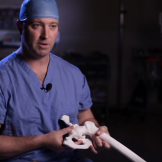
A specialty of orthopedics, hip preservation uses the least invasive techniques to decrease pain and disability without implanting joint replacements. There are many aspects of the anatomy of the hip, which can cause inconvenient symptoms for active lifestyles. This may be overcome by therapy, changes in lifestyle, injections, and potentially, surgery.
What is Hip Impingement?
Also known as femoroacetabular impingement, hip impingement is one of the major causes of hip pain in active individuals. There are two major categories of this condition:
1. Cam impingement – the ball-shaped end of the head of the femur is misshapen and is unable to move without causing friction in the joint socket.
2. Pincer (pincher) impingement – lesions of the hip that cause damage.
Regardless of the type of impingement, the goal of hip preservation is to improve the mechanics of the hip back to normal. With hip preservation, a doctor can essentially change your anatomy and therefore reduce symptoms and lower your risk of arthritis.
The symptoms of hip impingement include:
- Stiffness and decreased rotation and overall range of motion
- The inability to lift your leg higher than your hip
- Pain in the groin area after running, jumping or sitting for extended periods
A Non-Invasive Option: Hip Arthroscopy
Hip arthroscopy is a procedure where a surgeon inserts a small camera into the joint to identify, diagnose and treat conditions. Using small incisions, hip arthroscopy can typically take care of these changes in the hip, helping minimize pain and recovery. Pincer and cam impingement can be diminished. Hip arthroscopy is highly effective and is typically considered a day surgery.
Other changes of the hip that can be improved at the time of arthroscopy are lesions of the cartilage, tears in the labrum or ligaments, snapping or torn tendons, and loose bodies of cartilage or bone. Lesions of the cartilage can often be treated through excision (cleaning of the edges of the tear). However, sometimes micro-fracturing or drilling of the bone is mandatory.
No matter the particular course of action, the goal of hip joint preservation is to ultimately delay replacement surgery. At MOSH, we prioritize non-surgical options for hip pain. If and when all non-surgical options are exhausted, we will discuss with you the risks and benefits of surgery. But it is always our goal to avoid or delay hip surgery.
For more information on hip preservation, see an expert at Midwest Orthopedic Specialty Hospital.